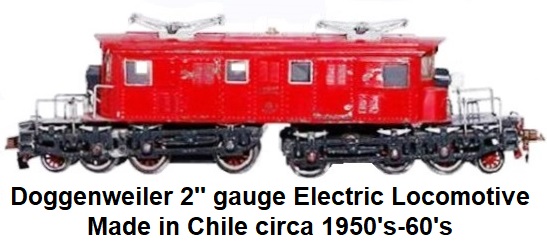 Doggenweiler tinplate electric trains were manufactured in Santiago, Chile, from 1933
until about 1960. The venture was the brainchild of Germán Doggenweiler and his close friend Jorge Yrarrázabal. The trains
were originally sold under the trademark of D & Y. In 1939 Germán died at the age of 30 as a result of a heart condition
and the future of the company looked bleak. The situation was further compounded by Jorge's death seven months later in a
horseback riding accident. Surviving Doggenweiler brothers Carlos and Rene, along with Germán's and Jorge's widows
continued to operate the toy train company. The company managed to struggle through the decade of the 1940's and by 1950 the
operation of the company was totally in the hands of Rene Doggenweiler, Germán's widow, and her son and the trademark was
changed to DYG. Rene continued operation through 1960 with Romilio Peredo serving as the company administrator.
During regular production years 3 electric outline locomotives were manufactured, modelled on engines
running in Chile. Two of the models were of Baldwin-Westinghouse locomotives that began to cover the route between Puerto
and Mapocho in 1923 and remained in service until 1986. Passenger coaches based on prototype German passenger cars
built by Linke-Hofmann were also produced, along with freight wagons and accessories, all to a scale of 1:32.
Doggenweiler tinplate electric trains were manufactured in Santiago, Chile, from 1933
until about 1960. The venture was the brainchild of Germán Doggenweiler and his close friend Jorge Yrarrázabal. The trains
were originally sold under the trademark of D & Y. In 1939 Germán died at the age of 30 as a result of a heart condition
and the future of the company looked bleak. The situation was further compounded by Jorge's death seven months later in a
horseback riding accident. Surviving Doggenweiler brothers Carlos and Rene, along with Germán's and Jorge's widows
continued to operate the toy train company. The company managed to struggle through the decade of the 1940's and by 1950 the
operation of the company was totally in the hands of Rene Doggenweiler, Germán's widow, and her son and the trademark was
changed to DYG. Rene continued operation through 1960 with Romilio Peredo serving as the company administrator.
During regular production years 3 electric outline locomotives were manufactured, modelled on engines
running in Chile. Two of the models were of Baldwin-Westinghouse locomotives that began to cover the route between Puerto
and Mapocho in 1923 and remained in service until 1986. Passenger coaches based on prototype German passenger cars
built by Linke-Hofmann were also produced, along with freight wagons and accessories, all to a scale of 1:32.
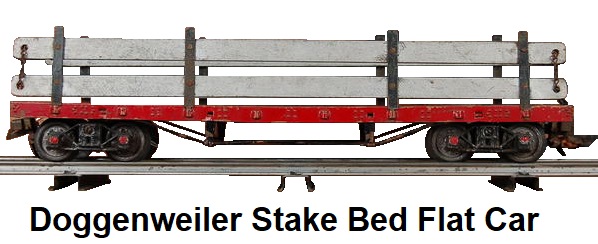
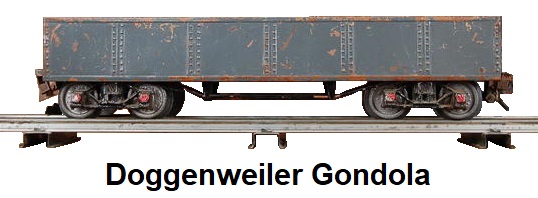
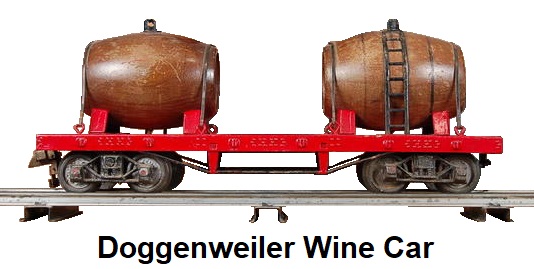
Doggenweiler was Chili's only electric model train manufacturer. Prior to the establishment of Doggenweiler, toy
trains were imported from Europe or the United States. The on-set of World War 2 created a severe disruption of trade and
imports in Chile. That was when Carlos and Germán Doggenweiler together with engineer Jorge Yrarrázabal took the initiative
and decided to become entrepreneurs in the toy business. Doggenweiler trains ran on 3-rail, 2" gauge tubular steel
track with wooden ties. Doggenweiler's track was exactly 2" between the centerpoints of the outside rails. This differs
from the Standard or Wide gauge popular track format utilized in the United States starting in 1906 through the 1930's by
manufacturers such as Lionel, American Flyer, and
Dorfan which was actually 2⅛" (nearly 54 mm) between the inside faces of the rails.
During their history Doggenweiler also manufactured
rolling stock in many colors, short four wheel freight cars, extra long passenger cars, some trolley cars without motors
that were never actually marketed, a toy ferris wheel that was electrically operated by turning on a light bulb, and many
more wonderful items.
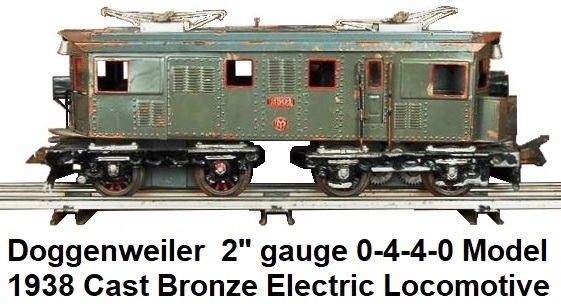 Doggenweiler electric locomotives were considered to be of high caliber and quality, made by artisans, but they also came
with a high price tag. The first loco produced was an 0-4-4-0 engine called 'Model 1938.' It was based on a
Baldwin-Westinghouse electric prototype used for hauling cargo by the State Railways of Chile between Santiago and the port
of Valparaiso. The model measured 30 centimeters long (12") and weighed almost 5 kilos (10.4 lbs.). The loco body was made
of sheet copper. This locomotive was introduced at the game fair in Caleta Abarca where boys, pressing a button, could
operate the engines and participate in exciting train races.These locomotives ran on alternating current (AC power).
Doggenweiler electric locomotives were considered to be of high caliber and quality, made by artisans, but they also came
with a high price tag. The first loco produced was an 0-4-4-0 engine called 'Model 1938.' It was based on a
Baldwin-Westinghouse electric prototype used for hauling cargo by the State Railways of Chile between Santiago and the port
of Valparaiso. The model measured 30 centimeters long (12") and weighed almost 5 kilos (10.4 lbs.). The loco body was made
of sheet copper. This locomotive was introduced at the game fair in Caleta Abarca where boys, pressing a button, could
operate the engines and participate in exciting train races.These locomotives ran on alternating current (AC power).
In 1944 Doggenweiler produced a large 4-4-4-4 electric locomotive weighing almost 30 lbs. This loco was
based on a 1922 Baldwin-Westinghouse E-28 prototype. The real locomotives were actually a 1+C+C+1. Chile had acquired 10
of these 3,000 volt 2,250 HP 115 ton locomotives numbered 2801 to 2810 for a price of US$127,000 each. These locos were
utilized for hauling express passenger trains. In 1950 a 4-wheel
loco was added to the Doggenweiler lineup. All of the Doggenweiler models were built using original drawings provided by
the State Railways of Chile.

Models of a first class passenger coach and a baggage car were built in the late 1930's. These cars
initially had no interior illumination, but lights were implemented in later production. Eventually freight cars for
carrying fuel oil, steel, coal, cattle and even wine were manufactured, along with trolleys and air planes. The
freight cars were based on the prototypes found in the yards of Salinas. Accessories were also developed, including green
and red flashing semaphores, bridges, automatically controlled grade crossings, gas
stations, bus stops and even a power house. In their best years, a peak of about 30 workers were employed in the factory
divided into a variety of jobs on the assembly line. In 1952, a transformer with a metal case was fitted with selenium
rectifiers to produce direct current (DC). Since the previous locomotives worked with AC, a switch controlled the current
for the locomotive. The Doggenweiler factory in Santiago located at Arturo Prat 166 was the company's own sales outlet for
many years and came to compete so well with foreign manufactuers such as Ives and
Lionel that an outlet in Valpariso at Pedro Montt 2014 was opened. In South and Central
America, Doggenweiler was the only company producing trains in 2" gauge from 1933 to 1960.
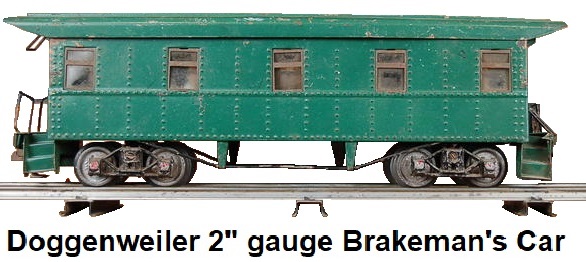 Like many of the USA based toy train companies, Doggenweiler published consumer catalogs. In 1947 or 1948
the Doggenweiler catalog displayed its cars and locos, each highlighted by a full-color cartoon character including Walt
Disney's Donald Duck, Mickey Mouse, and Pluto. The catalog was designed by Mrs. Doggenweiler, and was very colorful and
attractive. The 4-4-4-4 electric locomotive was used in the Doggenweiler passenger set while the 0-4-4-0 electric
loco headed up the freight set. Passenger sets consisted of a locomotive, baggage car, coach, 16 pieces of Doggenweiler
curved track including power terminal, four straights, and one bumper. In the 1940's and 50's, operating Doggenweiler train
layouts were prominently featured in the showcase window displays of Gath and Chavez, the multi-stores of British roots, in
Santiago and Valparaíso during the Christmas Holidays.
Like many of the USA based toy train companies, Doggenweiler published consumer catalogs. In 1947 or 1948
the Doggenweiler catalog displayed its cars and locos, each highlighted by a full-color cartoon character including Walt
Disney's Donald Duck, Mickey Mouse, and Pluto. The catalog was designed by Mrs. Doggenweiler, and was very colorful and
attractive. The 4-4-4-4 electric locomotive was used in the Doggenweiler passenger set while the 0-4-4-0 electric
loco headed up the freight set. Passenger sets consisted of a locomotive, baggage car, coach, 16 pieces of Doggenweiler
curved track including power terminal, four straights, and one bumper. In the 1940's and 50's, operating Doggenweiler train
layouts were prominently featured in the showcase window displays of Gath and Chavez, the multi-stores of British roots, in
Santiago and Valparaíso during the Christmas Holidays.
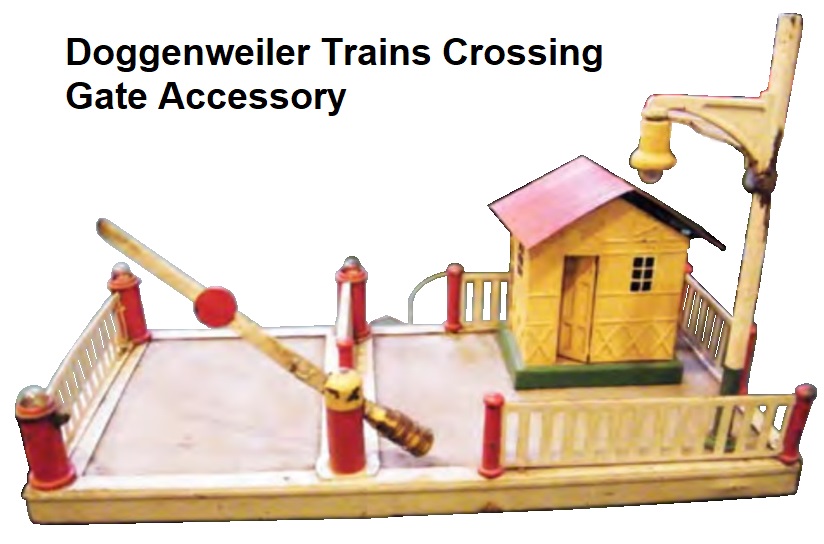 1952 was considered to be the peak year of production, however the company saw a need for diversification
and by 1954 Doggenweiler had expanded into radiant heat products. In the post war era imported toys reappeared in Chile.
By 1960, economic problems developed due to competition from foreign importers with cheaper prices and smaller scales. Train
manufacturing ceased. In 1961 the company was still in business but focusing production on their line of heaters.
1952 was considered to be the peak year of production, however the company saw a need for diversification
and by 1954 Doggenweiler had expanded into radiant heat products. In the post war era imported toys reappeared in Chile.
By 1960, economic problems developed due to competition from foreign importers with cheaper prices and smaller scales. Train
manufacturing ceased. In 1961 the company was still in business but focusing production on their line of heaters.
Doggenweiler trains are very rare, especially outside of Chile, and are highly sought after today by
collectors who know about them. At a 2011 auction held in Chile, a collection of Doggenweiler trains consisting of six
locomotives, 10 passenger cars, 28 freight cars and various accessories, all in very good condition, brought in five million
pesos (roughly $6,247.66 in United States Dollars).
